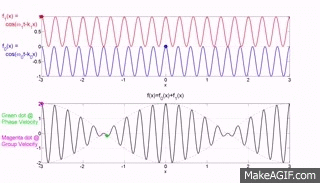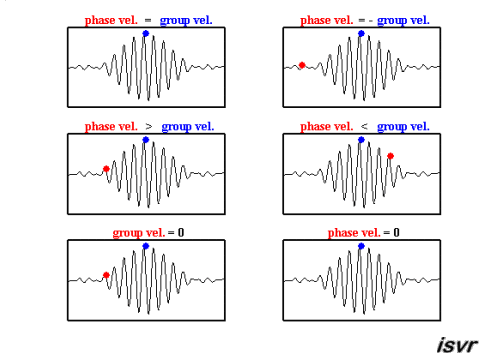The top two graphs from the MakeaGIF.com website are for waves of one frequency/wavelength travelling at different phase speed as shown by the motion of the red and blue dot sitting on top of a crest.
The term phase is used because you are observing the particle which make up the medium at their maximum upward excursion from the equilibrium position and the speed of that crest is measured as the distance moved by a crest divided by the time taken to move that distance.
You could have equally well chosen to follow a trough or when the particles had zero displacement or the phase $kx-\omega t = \text{constant}$.
Differentiating this expression gives the phase speed as $\left (\dfrac{dx}{dt}\right)_{\rm phase} = \dfrac \omega k$

The bottom graph is the addition of the top two graphs and you will note that a modulating envelope the peak of which as shown by the red dot travels at the group velocity where group refers to the motion of a number (group) of waves added together and $\left (\dfrac{dx}{dt}\right)_{\rm group} = \dfrac {\Delta\omega} {\Delta k}$.
This is derived from French's cosine term where you want the term in the bracket to be a maximum with $\omega = \omega_1-\omega_2$ and $\Delta k = k_1- k_2$ and follow the movement of that maximum.
Hopefully the gif animations below from the Institute of sound and Vibration Research (isvr) will help you to differentiate between group velocity and phase velocity.

Your function for the pressure (which you denote with s(r, t)) is correct but let us express it in the complex domain (we will take the real part at the end of our calculations). It becomes (Please note that I have also rearranged the terms in the exponent)
$$s(r, t) = \frac{A}{r} e^{j(\omega t - k r)} ~ (1)$$
Now, from Euler's equation (momentum equation) we know that
$$\nabla s = - \rho \frac{\partial u}{\partial t} ~ (2)$$
where $\rho$ is the medium density (we assume that the perturbed density is identical to the static one) and $u$ is the particle velocity.
In spherical coordinates, after omitting the radial components (due to symmetry, there is no change in any of the radial components and the derivative with respect to them is identically zero) Euler's equation becomes
$$\frac{\partial s}{\partial r} = - \rho \frac{\partial u}{\partial t} ~ (3)$$
By combining equations (1) and (3) we get
$$-\rho \frac{\partial}{\partial t} \left[u e^{j \left( \omega t - k r \right)} \right] = \frac{\partial}{\partial r} \left[ \frac{A}{r} e^{j \left( \omega t - k r \right)} \right] \implies
-j \rho \omega u = -\frac{\left(A j k r + A \right)}{r^{2}} e^{j \left(\omega t - k r \right)} \implies \\ \implies -j \rho \omega u = -\frac{A \left(1 + j k r \right)}{r^{2}} e^{j \left(\omega t - k r \right)} \implies -j \rho \omega u = -\frac{\left(1 + j k r \right)}{r} \frac{A}{r} e^{j \left(\omega t - k r \right)} \implies \\ -j \rho \omega u = -\frac{\left(1 + j k r \right)}{r} s \implies -j \rho \omega u = -\frac{s + s j k r}{r} \implies u = \frac{s + s j k r}{j \rho \omega r} \implies \\ \implies u = \frac{s}{j \rho \omega r} + \frac{s k}{\rho \omega} \implies u = \frac{s k}{\rho \omega} \left( 1 + \frac{1}{j k r} \right) ~ (4)$$
Now, by noting that $k = \frac{\omega}{c} \implies c = \frac{\omega}{k}$ you write the last part of (4) as
$$u = \frac{s}{\rho c} \left( 1 + \frac{1}{j k r} \right) ~ (5)$$
Such a lengthy derivation it is but we are going to need it. Before moving forward to look into how this can help us to find out how to calculate the intensity it's worth noting that the relation of pressure and particle velocity is frequency ("hidden" in the wavenumber $k$) and distance dependent. The further away you go from the source, or the higher the frequency becomes, the more in-phase those two quantities are.
Next, based on what I assume to be considered known, we state that the intensity is the product of sound pressure and particle velocity. That is
$$I = p u ~ (6)$$
Since we use complex notation but we are only interested in the real part of the intensity we get (please refer to some textbook for a more in-depth explanation of why this is true)
$$I_{r} = \frac{1}{2} \Re \left[ p u^*\right] ~ (7)$$
where the subscript $r$ denotes that this is the real part of the quantity, $\Re$ denotes the real part and $[ ~ \cdot ~ ]^{*}$ denotes complex conjugation. Thus, by using equations (1) and (5) into (7) we get
$$I_{r} = \frac{1}{2} \Re \left[ \frac{A e^{j \left(\omega t - k r \right)}}{r} \frac{A^{*} e^{-j \left(\omega t - k r \right)}}{\rho c r} \right] \implies I_{r} = \frac{1}{2} \Re \left[ \frac{A A^{*} e^{j \left(\omega t - k r \right)} e^{-j \left(\omega t - k r \right)}}{\rho c r^{2}} \right] \implies \\ \implies I_{r} = \frac{\left| A \right|^{2}}{2 \rho c r^{2}} \implies I_{r} = \frac{\left| s \right|^{2}}{2 \rho c} ~ (8)$$
where in the last part of (8) $I_{r}$ is valid only for time averages of harmonic functions over some multiple of the period (usually root-mean-square values are used instead for real life applications).
For more information on sound intensity you can refer to some well known textbooks such as Fundamentals of Acoustics by Kinsler et al. or (maybe even better) Sound Intensity by Frank Fahy. Please note that those are mere suggestions based on my personal preferences and experience and they are not meant to act as some promotion of said resources. Additionally, please bear in mind that you could very well find equivalent information on other "general acoustics" textbooks.


Best Answer
I assume you are referring to what happens when such a plane wave is propagating parallel to a solid surface. You are correct that strictly speaking, the acoustic particle velocity, like the mean flow velocity, must obey the no-slip condition at the wall. Viscous effects become important very close to the wall only, such that the acoustic motions are no longer sufficiently described by the classical wave equation, as they are far away from the wall.
Consider a plane wave of the type you specified traveling adjacent to a wall. The linearized momentum and energy equations may be written like so:
$$ \bar{\rho}\frac{\partial u'}{\partial t} + \frac{\partial p'}{\partial x} = \mu\frac{\partial^2 u'}{\partial y^2} $$
$$ \bar{\rho}c_p\frac{\partial T'}{\partial t} - \frac{\partial p'}{\partial t} = k\frac{\partial^2 T'}{\partial y^2} $$
Recall that in normal boundary layer theory we neglect the pressure gradient normal to the wall on the hypothesis that the boundary layer is thin. So, although the velocity changes considerably throughout the region, the pressure remains approximately at its free-stream value throughout. This is one of the crucial assumptions of boundary layer theory generally, and we have written the acoustic boundary layer equations above under the same assumption.
Following the pressure argument, we may replace the $ \partial p'/\partial x $ term with the rate of change of the acoustic momentum due to the wave in the free stream. Likewise, we may set the acoustic pressure to that of the free stream wave in the energy equation:
$$ \bar{\rho}\frac{\partial u'}{\partial t} - \bar{\rho}\frac{\partial u'_\infty}{\partial t} = \mu\frac{\partial^2 u'}{\partial y^2} $$
$$ \bar{\rho}c_p\frac{\partial T'}{\partial t} - \frac{\partial p'_\infty}{\partial t} = k\frac{\partial^2 T'}{\partial y^2} $$
Now, assuming all quantities vary harmonically as $ e^{i\omega t} $, we may develop analytical solutions for the acoustic particle velocity and temperature within the boundary layer:
$$ u(y) = u_\infty [1 - e^{-(1+i)y/\delta_u}]e^{i\omega t} $$
$$ T(y) = T_\infty [1 - e^{-(1+i)y/\delta_T}]e^{i\omega t} $$
where $ \delta_u =\sqrt{2\mu/\bar{\rho}\omega} $ and $ \delta_T = \delta_u/\sqrt{Pr} $ are respectively, the boundary layer thicknesses of the velocity and temperature fields. An animation for a free stream wave frequency of 30 Hz and Pr = 1.5 is shown below to better understand these solutions. So indeed, very close to the wall we see lag effects on the velocity which causes it to be out of phase with the velocity (and hence pressure) in the free stream. The velocity vectors are in blue, and the temperature is in red.
If this was not exactly what your question was referring to, I apologize for misinterpreting.